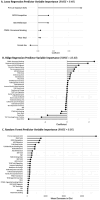Who is alcohol cue-reactive? A machine learning approach
- PMID: 40838757
- PMCID: PMC12368849
- DOI: 10.1093/alcalc/agaf052
Who is alcohol cue-reactive? A machine learning approach
Abstract
Background: The alcohol cue-exposure paradigm is widely used in alcohol use disorder (AUD) research. Individuals with AUD exhibit considerable variability in their alcohol cue-reactivity, highlighting the need to identify characteristics that contribute to this heterogeneity. This study applied machine learning models to identify clinical and sociodemographic predictors of subjective alcohol cue-reactivity (ALCUrge).
Methods: Individuals with AUD (N = 139; 83 M/56F) completed an alcohol cue-exposure paradigm and a battery of clinical and sociodemographic measures. ALCUrge (primary outcome variable) was assessed using the Alcohol Urge Questionnaire following alcohol cue-exposure. We implemented three machine learning models (Lasso regression, Ridge regression, Random Forest) to identify clinical and sociodemographic predictors of ALCUrge and compared model performance (i.e. predictive accuracy).
Results: Lasso regression had the strongest predictive accuracy, with a Root Mean Square Error (RMSE) of 9.48, followed by Random Forest (RMSE = 9.95), and Ridge regression (RMSE = 10.40). All models outperformed chance-level prediction (null baseline model RMSE = 14.80). Top predictors of ALCUrge across multiple models were alcohol urge prior to cue-exposure, compulsive alcohol-related behaviors/thoughts, tonic alcohol craving, cigarette smoking status, and biological sex. Higher pre-cue exposure alcohol urge, more compulsive alcohol-related tendencies, greater tonic craving, and occasional cigarette use was associated with greater predicted ALCUrge, while being female was associated with lower predicted ALCUrge.
Conclusion: This study advances our understanding of the phenotypic overlap in the compulsive aspects of tonic craving and phasic cue-induced alcohol urge, and offers insight into additional factors, such as biological sex and cigarette smoking, that may contribute to variability in alcohol cue-reactivity.
Keywords: addiction; alcohol use disorder; craving; cue-reactivity; machine learning; random forest; regression.
© The Author(s) 2025. Published by Oxford University Press on behalf of the Medical Council on Alcohol and Oxford University Press.
Figures


Similar articles
-
Characterizing alcohol cue reactive and non-reactive individuals with alcohol use disorder.Addict Behav. 2024 Aug;155:108028. doi: 10.1016/j.addbeh.2024.108028. Epub 2024 Apr 10. Addict Behav. 2024. PMID: 38640885 Free PMC article.
-
Prescription of Controlled Substances: Benefits and Risks.2025 Jul 6. In: StatPearls [Internet]. Treasure Island (FL): StatPearls Publishing; 2025 Jan–. 2025 Jul 6. In: StatPearls [Internet]. Treasure Island (FL): StatPearls Publishing; 2025 Jan–. PMID: 30726003 Free Books & Documents.
-
Neural Correlates of Stress and Alcohol Cue-Induced Alcohol Craving and of Future Heavy Drinking: Evidence of Sex Differences.Am J Psychiatry. 2024 May 1;181(5):412-422. doi: 10.1176/appi.ajp.20230849. Am J Psychiatry. 2024. PMID: 38706332 Free PMC article.
-
Virtual reality interventions in the assessment and treatment of alcohol use disorder - a systematic scoping review on methodology.Addict Sci Clin Pract. 2025 Aug 8;20(1):64. doi: 10.1186/s13722-025-00587-6. Addict Sci Clin Pract. 2025. PMID: 40781692 Free PMC article.
-
Preclinical and clinical sex differences in the effects of alcohol on measures of brain dopamine: a systematic review.Biol Sex Differ. 2025 Apr 8;16(1):24. doi: 10.1186/s13293-025-00706-7. Biol Sex Differ. 2025. PMID: 40200334 Free PMC article.
References
-
- Beck AT, Epstein N, Brown G. et al. Beck anxiety inventory. J Consult Clin Psychol. 1993;61:194–8.
-
- Beck, A. T., Steer, R. A., Brown, G. 1996. Beck depression inventory–II. Psychological assessment.
MeSH terms
Grants and funding
LinkOut - more resources
Full Text Sources
Medical

